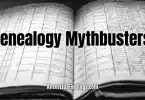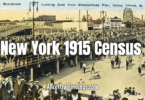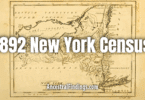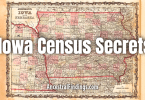When people talk about the U.S. Census, most think of it as just a headcount. But by 1880, the census had become something far more powerful. It wasn’t just about population totals or determining how many representatives each state should send to Congress—although that was still its constitutional purpose. The 1880 census was the most detailed snapshot of American life ever taken up to that point. It didn’t just tell the government how many people were living in the country. It told them who those people were, what they did, what challenges they faced, and where the country was headed.
For family historians, this census is a goldmine. It’s the first to name relationships to the head of household, which completely changes how we understand family structure. It also includes one of the earliest and most detailed efforts to record medical conditions, occupations, and birthplaces of parents—opening doors to trace ancestors back another generation.
But to truly appreciate the 1880 census, you have to understand what made it different—and why it still matters.
A Nation at a Crossroads
The 1880 census was taken in a country that was still healing from the Civil War but looking forward to the future. The industry was booming. Railroads were crossing the continent. Immigrants were arriving in huge numbers from Ireland, Germany, Scandinavia, and increasingly from Italy, Russia, and Eastern Europe. The South was still in economic disrepair, and the Reconstruction era had officially ended just three years earlier, in 1877. Western territories were growing fast. Native American lands were being taken or controlled. And the federal government wanted real data to understand how this new America was shaping up.
This was the tenth national census, and it introduced sweeping changes in how information was gathered and used.
What Was Collected in 1880
For each person in the household, census takers recorded their full name, age, sex, race, marital status, relationship to the head of the household, birthplace, and the birthplaces of both parents. That last detail—the birthplace of each person’s mother and father—is especially valuable for genealogists since it gives clues about migration patterns, heritage, and the generation before.
The census also recorded occupation, whether a person was unemployed due to disability, and whether they were blind, deaf, “insane,” or “idiotic”—terms used at the time. While those labels are outdated and insensitive today, they offer insight into how the country was starting to address disability and health as part of its demographic picture.
If someone had been sick or injured within the last year, that too was recorded—sometimes with the cause. You’ll occasionally see notes like “fever for 3 months,” “broken hip,” or “rheumatism,” which give researchers clues as to why someone may have been absent from work, struggled financially, or was not present in later records.
The census even asked if children had attended school during the year and whether adults could read and write. These details paint a picture of both family structure and opportunity, especially when comparing households across generations or social status.
A New Era of Census Taking
One of the most significant changes in 1880 was who took the census. In prior years, U.S. Marshals were responsible for collecting data. But in 1880, for the first time, the government hired specially trained census enumerators who were assigned to smaller, more manageable districts.
This meant more consistent information, better coverage in cities, and—at least in theory—more accurate reporting. Enumerators were expected to personally visit every household and complete the schedule with greater care. This also resulted in better handwriting and more complete answers in many areas, though errors still occurred, especially in rural places or among immigrant populations with language barriers.
The census was no longer just a way to count voters or divide up political power. It was a tool for policy making. Congress wanted to know how many people were working, what jobs they held, how many were attending school, how disease and disability affected the population, and what patterns of immigration and birth were shaping the states. This was the first census where demographics were used to drive decisions about health, industry, education, and even military planning.
Why the 1880 Census Matters to Family Historians
The real breakthrough for genealogists came with one small addition: the relationship to the head of the household column. For the first time, we can see not just who was living together but how they were related.
This allows researchers to build out families with much more confidence. A woman listed as “wife,” a child as “son,” or a widowed mother-in-law now identified by name—these are powerful connections. In earlier censuses, we had to guess based on age and position. In 1880, the guesswork dropped dramatically.
The listing of birthplaces for parents also helps break through brick walls. If someone’s father was born in Ireland and their mother in New York, you now know where to look next. In families with older children born in one state and younger children born in another, you can trace migration with greater precision.
For African American families, the 1880 census continues the thread that started in 1870. Many formerly enslaved individuals who first appeared by name in the 1870 census are now established heads of households, often with property, involvement in the church, or new careers. In areas with Freedmen’s schools and churches, you’ll see evidence of rising literacy, children attending school, and growing independence.
Hidden Insights and Underused Features
There are a few often-overlooked features in the 1880 census that researchers should be aware of.
First, the Disability and Health columns sometimes contain rich detail. Notes like “crippled in war,” “paralyzed,” or “feeble-minded since birth” give context to why someone may not appear in later records or may have lived in a poor house or hospital. This can lead you to institutional records, hospital registers, or even Civil War pension files.
Second, the 1880 census is where orphans and institutionalized people were listed more carefully. Orphanages, insane asylums, jails, and poorhouses were now included in their schedules, and in many cases, you can find names of children or adults who are missing from their families but are listed in these places.
Third, the 1880 census was the last one for which the entire original dataset survived and was indexed and digitized for every state—until 1900. (Most of the 1890 census was destroyed in a fire.) That makes 1880 incredibly important for placing your family just before the gap.
State and County-Level Clues
In 1880, many states still kept state censuses, often between federal census years. If you’re trying to trace someone who disappears before 1900, or if the 1880 census entry feels incomplete, check for state censuses in 1885, 1890 (a few states), or even earlier.
Property maps, tax rolls, and church membership lists from the late 1870s and early 1880s can also help fill in the local context. If a household had several school-aged children, school attendance records—especially for one-room schools or Black Freedmen’s schools—might confirm names and ages.
Final Thoughts
The 1880 census marked a turning point—not just for government planning but for how we understand the past. For the first time, we could see households in a meaningful, connected way. We could trace our parents and grandparents, follow migration through their children’s birthplaces, and understand how occupation, education, and illness shaped their daily lives.
It’s more than a list of names. It’s a reflection of a country finding its rhythm again after war, growth, and national change. And for family historians, it’s a foundational record—one that still offers insight, connection, and a surprising amount of detail when you know where to look.
Spend time with this census. Read it slowly. Look not just at the names in your family but at the ones surrounding them. You’ll likely find connections you didn’t expect—and maybe even answers to questions you’ve been carrying for a long time.






